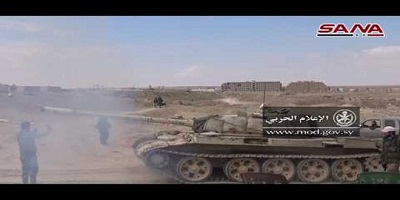Undoubtedly, Syrian Arab army will achieve a major victory against foreign -backed terrorist originations in Jobar, Barzeh, Qaboun, Harasta districts in Damascus and in the Eastern Ghouta of Damascus.
This victory will be enhanced with another victory in the northern countryside of Hama and will tip the scales, according to Firil Center for Studies in Berlin.
The center recently published two reports on attacks on east of Damascus and on the northern countryside of Hama province where important details were unveiled.
The first report said: On March 19th 2017, foreign-backed armed groups that have been holding up in Jobar, Qaboun and Barzeh districts east of Damascus city, launched the fiercest attack on the city since the start of foreign-backed terror war on Syria in 2011.
The attack was launched by three armed groups – Failaq al-Rahman [al-Rahman legion], Haye’tTahrir al-Sham [ al-Sham Liberation Commission] and HarakatAhrar al-Sham- which are affiliated to al-Qaeda, Muslim Brotherhood and Saudi Wahhabi thinking.
Failaq al-Rahman is an extremist organization composed of radical groups operating in Damascus countryside and the eastern part of Qalamoun. Its leader in Jobar district is Abdul al-NaserShmir -a dissident officer since 2012-It receives support from Israel and Saudi Arabia via Jordan and it has medium and heavy weapons plus US missiles as the first brigade of ‘Free army’ joined it in April 2016.It has troubled relationship with ‘Jaish al-Islam’ because of competition for leadership. [10% of its fighters is from Jordan, Lebanon and Saudi Arabia]
Haye’tTahrir al-Sham / al-Nusra Front [Jabhat al-Nusra] is a military union composed of al-Nusra Front, Noreddin al-Zenki movement, al-Haq brigade, al-Sunneh army and AnsarEddin Front. It was formed by the beginning of 2017 and included groups that had rejected Astana conference. It is headed by Sheikh Abo Jaber. It is affiliated to al-Qaeda and receives support from Saudi Arabia, Qatar and Turkey. [20% of its fighters is from Iraq, Saud Arabia and Chechnya].
Ahrar al-Sham movement, founded in 2011, includes four extremist groups: Ahrar al-Sham battalions, al-Fajer Movement, al-Tale’a group and al-Iman battalion. It also includes fighters from Afghanistan and Iraq. It has good experience in suicide attacks and car bomb and it has strong military relations with al-Nusra Front. It spreads in all Syrian provinces and it receive support from Qatar, Saudi Arabia and turkey.[20% of its fighters is from Chechnya, Iraq and Saudi Arabia].
The above mentioned groups received – on March 7th 2017- orders from Saudi Arabia and arms and money via Jordan to launch the attack in order to break the siege imposed on gunmen in Barzeh and Qaboun districts and to carry out a breach in order to raise morale of gunmen in other areas as well as to abort Intra-Syrian talks in Astana.
Over 894 attackers out of 6700 killed
The attack coincided with fabricated reports circulated by media outlets supporting gunmen. It made no military progress on the ground, except gunmen’s temporary infiltration into some industrial areas. It was the 18th failed attempt made by gunmen to reach al-Abasseyen square in Damascus.
The two-stage attack was carried out by 6700 gunmen and it was thwarted by Syrian army only.
17 suicide bombers including 3 women from Saudi Arabia, Chechnya and Jordan blow themselves up during the attacks. More than 894 gunmen were killed and 1318 others wounded and more than 120 others missed during Syrian army’s operations there.
Further gunmen are to be killed in the ongoing battle in the northern countryside of Hama, according to the center’s second report, which clarified that the battle of northern Hama countryside has been waged by Muslim Brotherhood in Turkey in order to gain a political role in Syria’s future.
“Erdogan lost control in the north-eastern part of Syria and he wants to achieve gains in Hama after the failure of his bet on Damascus and Aleppo,” the report said indicating that the attack on Hama is also in the interest of the United States that airdropped forces in several areas east of Euphrates in Tabaqa towards Raqqa.
The airdrop synchronized with attack on Hama in order to prevent Syrian Arab army from moving towards Raqqa province through Tabaqa.
Result of Hama battle is essential and it will tip the scales and will lead to a positive change towards the Syrian leadership at international and regional levels, the center expected, asserting that Syrian Arab army and allied forces will defeat terrorists in Hama.
Basma Qaddour

